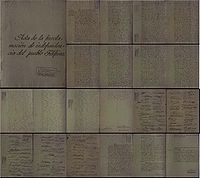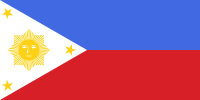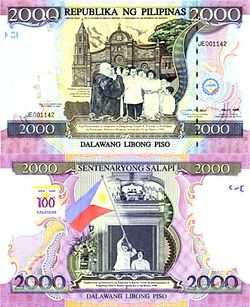- Philippine Declaration of Independence
-
For Main article Independence Day (Philippines). For more information History of the Philippines (1946–1965), Treaty of Manila (1946).
Philippine Declaration of Independence 
Created May–June 1898 Ratified June 12, 1898 Location National Library of the Philippines Authors Ambrosio Rianzares Bautista
Emilio AguinaldoSignatories 98 delegates Purpose To proclaim the sovereignty and independence of the Philippines from the colonial rule of Spain The Philippine Declaration of Independence occurred on June 12, 1898 in Cavite II el Viejo (now Kawit), Cavite, Philippines. With the public reading of the Act of the Declaration of Independence, Filipino revolutionary forces under General Emilio Aguinaldo proclaimed the sovereignty and independence of the Philippine Islands from the colonial rule of Spain, which had been recently defeated at the Battle of Manila Bay during the Spanish-American War.
The declaration, however, was recognized by neither the United States nor Spain. The Spanish government later ceded the Philippines to the United States in the 1898 Treaty of Paris that ended the Spanish-American War. The United States finally recognized Philippine independence on July 4, 1946 in the Treaty of Manila.[1] July 4 was observed in the Philippines as Independence Day until August 4, 1964 when, upon the advice of historians and the urging of nationalists, President Diosdado Macapagal signed into law Republic Act No. 4166 designating June 12 as the country's Independence Day.[2] June 12 had previously been observed as Flag Day and many government buildings are urged to display the Philippine Flag in their offices.
Contents
The Proclamation Day
.
In the presence of a huge crowd, independence was proclaimed on June 12, 1898 between four and five in the afternoon in Cavite at the ancestral home of General Emilio Aguinaldo some 30 kilometers South of Manila . The event saw the unfurling of the National Flag of the Philippines, made in Hong Kong by Marcela Agoncillo, Lorenza Agoncillo, and Delfina Herboza, and the performance of the Marcha Filipina Magdalo, as the Nation's National Anthem, now known as Lupang Hinirang, which was composed by Julián Felipe and played by the San Francisco de Malabon marching band.
The Act of the Declaration of Independence was prepared, written, and read by Ambrosio Rianzares Bautista in Spanish. The Declaration was signed by ninety-eight people, among them an American army officer who witnessed the proclamation. The final paragraph states that there was a "stranger" (stranger in English translation — extrangero in the original Spanish, meaning foreigner) who attended the proceedings, Mr. L. M. Johnson, described as "a citizen of the U.S.A, a Coronel of Artillery".[3] The proclamation of Philippine independence was, however, promulgated on the 1st of August, when many towns had already been organized under the rules laid down by the Dictatorial Government of General Aguinaldo.[4][5]
Later at Malolos, Bulacan, the June 12 proclamation was modified upon the insistence of Apolinario Mabini who objected to that the original proclamation essentially placed the Philippines under the protection of the United States.
Surrounding events
The Philippine Revolution
The Spanish-American War
Main article: Spanish-American WarThe Malolos Congress
The Philippine-American War
Main article: Philippine-American WarPhilippine Centennial
On June 12, 1998, the nation celebrated its centennial year of Independence from Spain. The celebrations were held simultaneously nationwide by then President Fidel V. Ramos and Filipino communities worldwide. A commission was established for the said event, the National Centennial Commission headed by former Vice President Salvador Laurel presided all events around the country. One of the major projects of the commission was the Expo Pilipino, a grand showcase of the Philippines' growth as a nation for the last 100 years, located in the Clark Special Economic Zone (formerly Clark Air Base) in Angeles City, Pampanga.
See also
- Katipunan
- Declaration of Independence
- Philippine–Spanish Friendship Day
- Filipino-American Friendship Day
- History of the Philippines
- Philippine Independence Day Parade
- Tydings-McDuffie Act (1935)
- Philippine Organic Act (1902)
- Jones Law (Philippines) Philippines Organic Act (1916)
- Treaty of Paris (1898)
- Filipino Repatriation Act of 1935
Notes
- ^ TREATY OF GENERAL RELATIONS BETWEEN THE UNITED STATES OF AMERICA AND THE REPUBLIC OF THE PHILIPPINES. SIGNED AT MANILA, ON 4 JULY 1946, United Nations, http://untreaty.un.org/unts/1_60000/1/6/00000254.pdf, retrieved 2007-12-10
- ^ REPUBLIC ACT NO. 4166 - AN ACT CHANGING THE DATE OF PHILIPPINE INDEPENDENCE DAY FROM JULY FOUR TO JUNE TWELVE, AND DECLARING JULY FOUR AS PHILIPPINE REPUBLIC DAY, FURTHER AMENDING FOR THE PURPOSE SECTION TWENTY-NINE OF THE REVISED ADMINISTRATIVE CODE, Chanrobles law library, August 4, 1964, http://www.chanrobles.com/republicacts/republicactno4166.html, retrieved 2008-06-11
- ^ Dean Conant Worcester, in his 1914 book The Philippines: Past and Present (Worcester 1914), says:
- "Invitations to the ceremony of the declaration of independence were sent to Admiral Dewey; but neither he nor any of his officers were present. It was, however, important to Aguinaldo that some American should be there whom the assembled people would consider a representative of the United States. 'Colonel' Johnson, ex-hotel keeper of Shanghai, who was in the Philippines exhibiting a cinematograph, kindly consented to appear on this occasion as Aguinaldo's Chief of Artillery and the representative of the North American nation. His name does not appear subsequently among the papers of Aguinaldo. It is possible that his position as colonel and chief of artillery was a merely temporary one which enabled him to appear in a uniform which would befit the character of the representative of a great people upon so solemn an occasion!"
- ^ Guevara, Sulpicio, ed. (1972), "Philippine Declaration of Independence", The Laws of the First Philippine Republic (The Laws of Malolos) 1898-1899., Manila: National Historical Commission, http://quod.lib.umich.edu/cgi/t/text/pageviewer-idx?c=philamer;cc=philamer;rgn=full%20text;idno=aab1246.0001.001;didno=aab1246.0001.001;view=image;seq=00000221, retrieved 2008-03-26. (English translation by Sulpicio Guevara)
- ^ Guevara, Sulpicio, ed. (1972), "Facsimile of the Proclamation of the Philippine Independence at Kawit, Cavite, June 12, 1898", The Laws of the First Philippine Republic (The Laws of Malolos) 1898-1899., Manila: National Historical Commission, http://quod.lib.umich.edu/cgi/t/text/pageviewer-idx?c=philamer&cc=philamer&idno=aab1246.0001.001&frm=frameset&view=image&seq=203, retrieved 2008-03-26. (Original handwritten Spanish)
References
- History of the Filipino People. Teodoro A. Agoncillo
- National Library of the Philippines
- Philippine History Group of Los Angeles
- Worcester, Dean Conant (1914), The Philippines: Past and Present (vol. 1 of 2), Macmillan, http://www.gutenberg.org/etext/12077, retrieved 2008-01-17
External links
- Acta de la proclamación de la independencia del pueblo Filipino Spanish version by Corpus Juris online Philippine law library
- Declaration of Philippine Independence English version by Corpus Juris online Philippine law library
- The Act of Declaration of Philippine Independence
- Philippine History Group of Los Angeles
- July 4, 1946: True Philippine Independence Day
- The Independence Day That Wasn't
- June 12, 1898 as Independence Day
- PHILIPPINES: Torn Between Two Colonisers -- Spain and America
- Philippines, CIA World Factbook
Philippine national holidays Regular holidays New Year's Day · Maundy Thursday · Good Friday · Araw ng Kagitingan · Labor Day · Independence Day · National Heroes' Day · Eid Al-Fitr · Bonifacio Day · Christmas Day · Rizal DaySpecial holidays Joana Rheea A.Delos Santos
Categories:- Declarations of independence
- Philippine–American War
- Philippine Revolution
- Holidays in the Philippines
- 1898 in international relations
Wikimedia Foundation. 2010.



